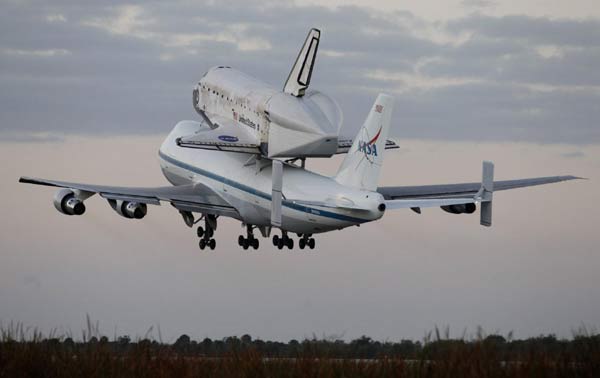
 |
|
The space shuttle Discovery, attached to a modified NASA 747 aircraft, takes off headed for its final home at The Smithsonian National Air and Space Museum's Steven F. Udvar-Hazy Center in Chantilly, Virginia, from the Kennedy Space Center in Cape Canaveral, Florida April 17, 2012. [Photo/Agencies]
|
The United States retired its space shuttles last year after finishing construction of the $100 billion International Space Station, a project of 15 countries, to begin work on a new generation of spaceships that can carry astronauts to destinations beyond the station's 240-mile-high (384-km-high) orbit.
Discovery, the fleet leader of NASA's three surviving shuttles, completed its last spaceflight in March 2011. It was promised to the Smithsonian Institution's National Air and Space Museum in Washington, D.C., the nation's official repository for space artifacts.
"It's sad to see this happening," said NASA astronaut Nicole Stott, a member of Discovery's final crew. "But you look at it and you just can't help but be impressed by it. That's my hope now, that every time someone looks at that vehicle they are impressed, that they feel that this is what we can do when we challenge ourselves."
For its last ride, Discovery took off not from its seaside launch pad but atop a modified Boeing 747 carrier jet that taxied down the Kennedy Space Center's runway at dawn. The shuttle's tail was capped with an aerodynamically shaped cone and its windows were covered.
"It's a very emotional, poignant, bittersweet moment," said former astronaut Mike Mullane, a veteran of three space shuttle missions. "When it's all happening you think, 'This will never end,' but we all move on."
After a loop around Washington, D.C., the shuttle carrier plane was scheduled to touch down at Washington Dulles International Airport between 10 a.m. and 11 a.m. EDT. Discovery, which first flew in August 1984, will then be transferred to the Smithsonian's nearby Steven F. Udvar-Hazy Center in Chantilly, Virginia.